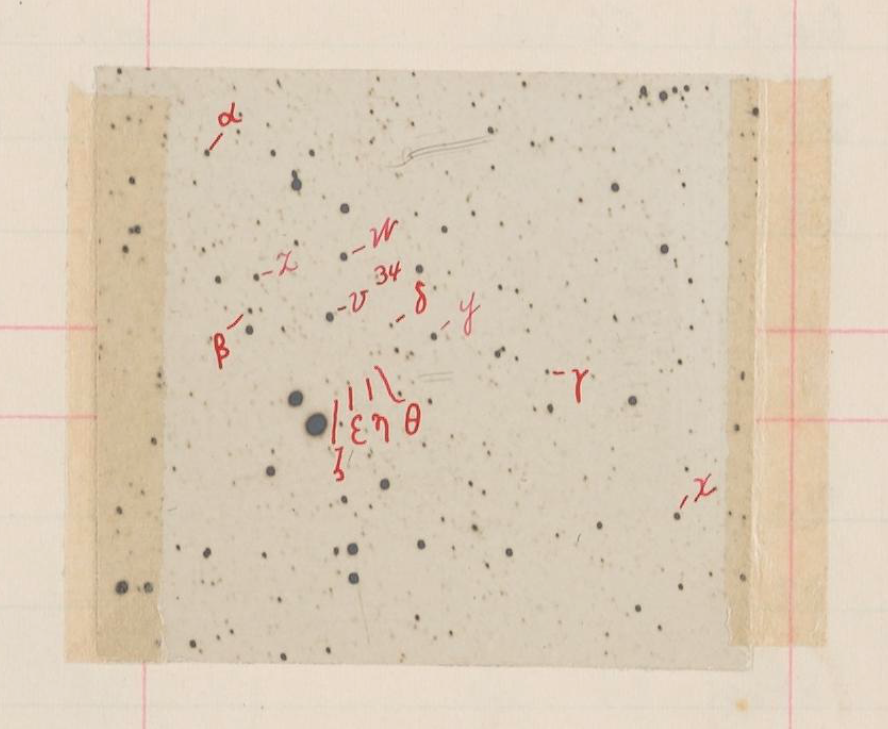From funding of projects through Kickstarter, to Waze’s user-led traffic and navigation app, to that free encyclopaedia that we all know and love, crowdsourcing has become increasingly ubiquitous. The approach is democratising the process of academic research by leveraging the collective intelligence of a crowd to accomplish tasks, gather information, or generate innovative ideas.
The “Star Notes” project – part of Project PHaEDRA at the Harvard-Smithsonian Centre for Astrophysics – is made possible through this collective process. Aimed at preserving and making accessible the work of early 20th-century women astronomers at Harvard College Observatory, the initiative’s purpose is to digitise, transcribe, and create metadata for their collection of female astronomers’ notebooks. These women’s under-recognised contributions played a crucial role in advancing the field of astronomy. My engagement with “Star Notes” is driven by an interest in the intersection of scientific innovation, human stories and collective efforts.



Participation Process
The process of engaging with the “Star Notes” project was both intuitive and enlightening. The Zooniverse platform hosts a wide range of projects that harness the collective power of volunteers for scientific and historical research. Navigating to the “Star Notes” project, I was greeted by a comprehensive tutorial designed to equip volunteers with the knowledge and tools necessary for the task at hand. Learning to identify non-textual items—ranging from astronomical sketches to personal doodles—required familiarisation with Zooniverse’s digital toolkit. This toolkit includes features for drawing rectangles around identified items and zooming into the intricacies of each notebook page.
Engagement with the actual identification involved discerning between pages that bore the marks of scientific inquiry – or, at times, of artistic distraction – and those that remained blank of non-textual elements. The challenge lay not in the technical aspects of using the platform but in the interpretive effort to discern between ‘astronomical sketches’, ‘diagrams and graphs’, and ‘doodles’. The additional ‘other’ category required an understanding of the historical context and significance of the marks left by these pioneering women astronomers.
This initial phase of participation in the “Star Notes” project was as much a learning experience as it was a contribution. It underscored the importance of the concepts of digital humanities in closing the gap between historical documents and contemporary research methodologies, and augmenting our efforts with the latest tools and innovative approaches.
The Meaning of Contribution
Contributions to the “Star Notes” project hold significant implications for the preservation of historical data, research advancement, and recognition of innovators. This initiative highlights the importance of safeguarding and democratising access to historical records. The preservation of fragile historical documents that are at risk of degradation is the first building block. By digitising these notebooks, the project ensures that the detailed observations and calculations of early astronomers are preserved. This effort not only safeguards the physical integrity of these documents but also makes them accessible to a global audience. The digitisation process transforms the notebooks into searchable, easily navigable resources, breaking down geographical and financial barriers that have historically limited access to such materials. This accessibility is paramount for researchers, educators, and the general public, fostering a deeper understanding and appreciation of historical astronomical research. It is this that provides the basis for more transformative outcomes, all enabled through collective preservation and transcription.
1. Advancement of Astronomical Research
The contributions to the “Star Notes” project significantly advance astronomical research by providing a rich context for historical observations. The 20th century saw some of the most astounding scientific discoveries and technological leaps in human history: The invention of the radio telescope; the beginning of the Voyager missions; the discovery of exoplanets; the observation of our expanding universe. These breakthroughs advanced our global civilisation and opened our collective perspective and are only a few examples from the most transformative time in history (yet!). The transcriptions of these notebooks, therefore, offer insights into the methodologies and data that 20th century astronomers used to make some of these ground-breaking discoveries. This context is invaluable for contemporary researchers, as it allows them to trace the evolution of astronomical knowledge and techniques. Furthermore, the creation of a comprehensive, searchable database of these transcriptions lays a solid foundation for future research. It enables modern scientists to build upon the historical data, potentially leading to new discoveries or reinterpretations of past observations. The project acts as a bridge between past and present astronomical research, highlighting the continuity of scientific inquiry and the importance of historical data in driving future advancements.
2. Recognition of Women in Science
Perhaps the most profound implication of the “Star Notes” project is its role in recognising and celebrating the contributions of women to astronomy. By focusing on the notebooks of women astronomers at the Harvard College Observatory, the project brings attention to their often-underrecognised work. This recognition challenges the traditional narratives that have marginalised women’s roles in science, promoting a more inclusive understanding of scientific history. The visibility of these women’s achievements serves as a powerful source of inspiration for current and future generations of scientists, especially women and girls, who aspire to careers in fields that push the envelope of understanding and possibility. Highlighting the contributions of these pioneering women not only honours their legacy but also encourages a more equitable scientific community.
Learning Through Contribution
The broader implications of the project extend beyond preservation and research. The crowdsourcing model employed democratises the scientific process, allowing people from various backgrounds to participate in academic research. This model fosters a sense of community and shared purpose among volunteers, enhancing public engagement with science and history. Moreover, the educational opportunities arising from participation in the project are significant. Volunteers gain insights into the history of astronomy, the process of scientific research, and the value of digital humanities methodologies in integrating historical documents and contemporary research.
Participating in the “Star Notes” project has afforded me insights into the interdisciplinary nature of research and the societal implications of science. The project underscored the significance of historical context in scientific inquiry. Engaging with the astronomers’ notebooks revealed how past methodologies and theories have evolved, shaping contemporary scientific practices. This experience highlighted the importance of primary sources in research, offering a tangible connection to the scientific thought processes and observational techniques of the early 20th century. Furthermore, the “Star Notes” project is an example of the potential for collaboration between the humanities and sciences. By employing digital tools to preserve and analyse historical astronomical data, the project not only bridges these fields but also demonstrates how such integration can enhance research outcomes. Digital archives and databases play a crucial role in making historical data accessible, facilitating interdisciplinary research that combines scientific inquiry with historical analysis.
Perspectives on Science and Society
The project also enriched my perspective on the evolution of scientific knowledge. It became evident that scientific advancements are built upon the cumulative efforts of numerous individuals, including many whose contributions have historically been overlooked. This iterative nature of discovery, documented in the notebooks, emphasises the continuity and collaborative spirit inherent in scientific research. It highlights to me the compounding effect of just putting in the work day by day…
“You don’t set out to build a wall. You don’t say, ‘I’m going to build the biggest, baddest, greatest wall that’s ever been built.’ You don’t start there. You say, ‘I’m going to lay this brick as perfectly as a brick can be laid. There will not be one brick on the fact of the Earth that’s going to be laid better than this brick that I’m going to lay in this next 10 minutes.’ And you do that every single day.
(Will Smith, 2002)
This philosophy is one that transcends the specifics of the discipline or task at hand, and it can be felt so clearly through the history of scientific contributions that have improved daily life and expanded understanding.
Leveraging People
Furthermore, the project’s crowdsourcing model illustrated the power of people. By engaging a diverse group of volunteers in the transcription and analysis of historical documents, the project becomes possible. It, secondarily, enhances public engagement with science but promotes a broader appreciation for the historical development of astronomical research. This approach fosters a sense of community and shared purpose, and shines a light on the importance of public participation in scientific endeavours.
Through this experience, my views on the relationship between science and society have developed. I’ve gained a greater appreciation for the role of education and public engagement in shaping scientific research and understanding. The “Star Notes” project has not only informed my perspective on the interconnectedness of scientific discovery, historical documentation, and societal progress but also invigorated my motivation for future involvement in digital humanities projects.
We Must All Turn Up Each Day
The “Star Notes” project not serves as a bridge connecting the past and present of astronomical research and presents a path for future applications in both scientific and humanities settings. This initiative plays an role in highlighting the approach behind and importance of digital archiving and cross-disciplinary collaboration in enhancing research methodologies across various fields.
The project has showcased the impact of employing digital tools for archiving, highlighting the importance of making scholarly materials accessible and preserved for future generations. This approach extends to all academic disciplines, advocating for a broader adoption of digital humanities tools and collective approaches. Furthermore, the “Star Notes” project highlights the benefits of cross-disciplinary collaboration, merging the humanities and sciences to enrich research outcomes. It presents a compelling case for integrating technology into traditional research, and, in turn, opening new avenues for data analysis, accessibility, and interpretation that can transcend disciplinary boundaries.
The project’s focus on the contributions of women astronomers has been especially enlightening, challenging traditional narratives and promoting a more inclusive history of scientific achievement. It serves as a powerful reminder of the importance of recognising and celebrating the contributions of those who have been historically ignored. Here is a need to advocate for the development of similar initiatives that leverage digital humanities to preserve and highlight historical data. Such projects not only contribute significantly to academic research but also play a crucial role in public education, historical accuracy and societal advancement more broadly.
It has also illustrated the iterative nature of innovation and the advancement of knowledge. As we all work on building, we must focus on the brick we have to lay next. While a small step forward in scientific inquiry – or a single, well-placed brick – may seem insignificant on its own, each contribution to science accumulates over time, leading to significant advancements and breakthroughs. This is a philosophy of patience, persistence, and precision in the pursuit of knowledge, reminding us that every effort, every study, and every data point is a step towards greater understanding and innovation. We must all turn up, to collaborate and investigate, so that we can push ever closer to the horizon of human knowledge.

